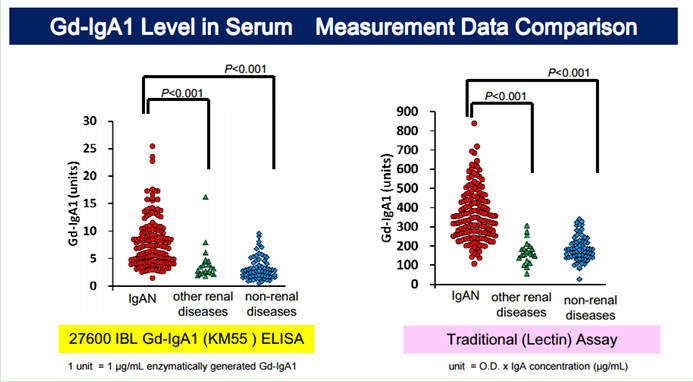A new biomarker of IgANephropathy (IgAN) and IgA vasculitis with nephritis (IgA-VN) was born.
Gd-IgA1 specific antibody ( KM55 ) /Gd-IgA1 detection kit
1 Introduction
A team led by Professor Yusuke Suzuki, professor of nephrology at the University of Juntendo University, reports that galactose-deficient IgA1 (Gd-IgA1) is a novel biomarker for IgANephropathy (IgAN) and IgA vasculitis with nephritis (IgA-VN). It is a useful tool.
In this study, 48 patients with IgAN and 49 patients with IgA-VN, lupus nephritis, HCV-associated nephropathy and membranous nephropathy were enrolled in renal biopsy specimens for paraffin-embedded sections with antibodies (KM55) for specific detection of Gd-IgA1. The pathophysiological significance of Gd-IgA1 in glomerular sediments of patients with IgAN was evaluated. The study found that Gd-IgA1 is specifically positive in IgAN and IgA-VN, but negative in other Nephropathy such as lupus nephritis.
It has been suggested that IgAN and IgA-VN have a common feature with respect to the pathogenic pathogenesis of galactose-deficient IgA1 (Gd-IgA1).
In a recent study, galactose-deficient IgA1 (Gd-IgA1) has attracted much attention as a key effector molecule in the pathogenesis and progression of IgANephropathy (IgAN). It has been suggested that several O-linked glycan modification regions are present in the heavy chain hinge region of the human IgA1 molecule, and Gd-IgA1 is circulating in the bloodstream of patients with IgAN pathological conditions. The deposition of Gd-IgA1 in the glomerulus is thought to be related to IgAN (the multiple hit hypothesis of Gd-IgA1). A measurement system using a snail agglutinin (HAX) and a Gd-IgA1 ELISA (galactose-deficient IgA1) assay kit extracted from snails has been used in many studies. These studies have shown that serum Gd-IgA1 levels in patients with IgAN are significantly higher than those in healthy subjects or patients with kidney disease other than IgAN. In addition, the antibody (KM55) can detect Gd-IgA1 and HAA in tissues by immunohistochemistry. Different characteristics of lectins have revealed the presence of Gd-IgA1 specificity in the glomeruli of IgAN patients in the study using this antibody, and measuring the level of Gd-IgA1 is of great significance. However, the measurement system using HAA lectin is not suitable for the measurement of a large number of large samples in large-scale studies due to the instability of its polysaccharide recognition activity, and the ELISA kit for detecting Gd-IgA1 uses a specific recognition of human Gd-IgA1. Monoclonal antibodies are characterized by high accuracy and specificity and are suitable for large-scale studies.
- Applications
2.1 Application of Gd-IgA1 specific antibody (KM55)

2.2 Application of Gd-IgA1 detection kit

- Related Products
Product number | Sample type | product name | examination range | Test sample | |||
serum | EDTA-plasma | Cell culture supernatant | Cerebrospinal fluid | ||||
27600 | people | Gd-IgA1 (Galactose-deficient IgA1) Assay Kit - IBL | 1.56-100ng/ml | √ | √ | x | x |
Product number | Sample type | product name | specification | application | |||
10777 | people | Anti-Human Gd-IgA1 (KM55) Rat IgGMoAb | 100ug | IHC | |||
10ug | |||||||
German DRG China agent: Shenzhen Kerunda Biological Engineering Co., Ltd.
Company Address: 7D, No. 45, Yanshan Road, Shekou, Nanshan District, Shenzhen
R&D address: 6th Floor, No. 10, Yanshan Road, Shekou, Nanshan District, Shenzhen
company phone
Company website:
Sales QQ
Customer service QQ
NINGBO MEDICAL EQUIPMENT CO.,LTD , https://www.techartmeds.com
